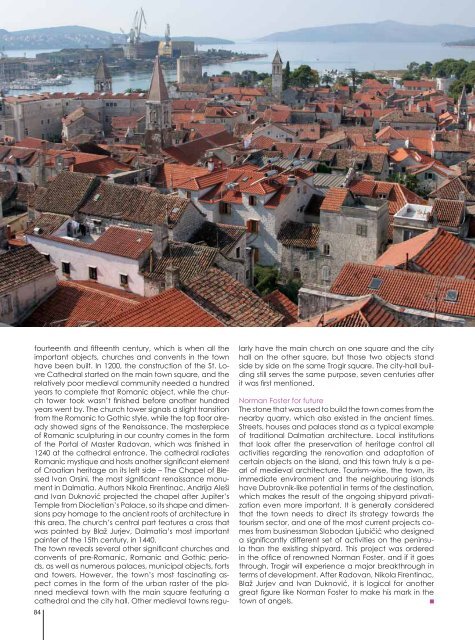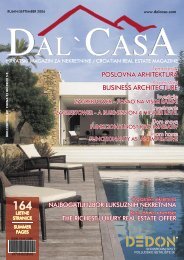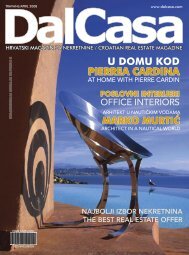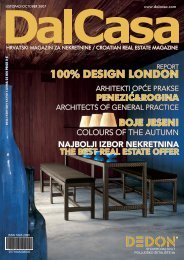TONY EKSKLUZIVNE VILE - DalCasa
TONY EKSKLUZIVNE VILE - DalCasa
TONY EKSKLUZIVNE VILE - DalCasa
- No tags were found...
You also want an ePaper? Increase the reach of your titles
YUMPU automatically turns print PDFs into web optimized ePapers that Google loves.
84fourteenth and fi fteenth century, which is when all theimportant objects, churches and convents in the townhave been built. In 1200, the construction of the St. LovreCathedral started on the main town square, and therelatively poor medieval community needed a hundredyears to complete that Romanic object, while the churchtower took wasn’t fi nished before another hundredyears went by. The church tower signals a slight transitionfrom the Romanic to Gothic style, while the top fl oor alreadyshowed signs of the Renaissance. The masterpieceof Romanic sculpturing in our country comes in the formof the Portal of Master Radovan, which was fi nished in1240 at the cathedral entrance. The cathedral radiatesRomanic mystique and hosts another signifi cant elementof Croatian heritage on its left side – The Chapel of BlessedIvan Orsini, the most signifi cant renaissance monumentin Dalmatia. Authors Nikola Firentinac, Andrija Alešiand Ivan Duknović projected the chapel after Jupiter’sTemple from Diocletian’s Palace, so its shape and dimensionspay homage to the ancient roots of architecture inthis area. The church’s central part features a cross thatwas painted by Blaž Jurjev, Dalmatia’s most importantpainter of the 15th century, in 1440.The town reveals several other signifi cant churches andconvents of pre-Romanic, Romanic and Gothic periods,as well as numerous palaces, municipal objects, fortsand towers. However, the town’s most fascinating aspectcomes in the form of the urban raster of the plannedmedieval town with the main square featuring acathedral and the city hall. Other medieval towns regularlyhave the main church on one square and the cityhall on the other square, but those two objects standside by side on the same Trogir square. The city-hall buildingstill serves the same purpose, seven centuries afterit was fi rst mentioned.Norman Foster for futureThe stone that was used to build the town comes from thenearby quarry, which also existed in the ancient times.Streets, houses and palaces stand as a typical exampleof traditional Dalmatian architecture. Local institutionsthat look after the preservation of heritage control allactivities regarding the renovation and adaptation ofcertain objects on the island, and this town truly is a pearlof medieval architecture. Tourism-wise, the town, itsimmediate environment and the neighbouring islandshave Dubrovnik-like potential in terms of the destination,which makes the result of the ongoing shipyard privatizationeven more important. It is generally consideredthat the town needs to direct its strategy towards thetourism sector, and one of the most current projects comesfrom businessman Slobodan Ljubičić who designeda signifi cantly different set of activities on the peninsulathan the existing shipyard. This project was orderedin the offi ce of renowned Norman Foster, and if it goesthrough, Trogir will experience a major breakthrough interms of development. After Radovan, Nikola Firentinac,Blaž Jurjev and Ivan Duknović, it is logical for anothergreat fi gure like Norman Foster to make his mark in thetown of angels.
















